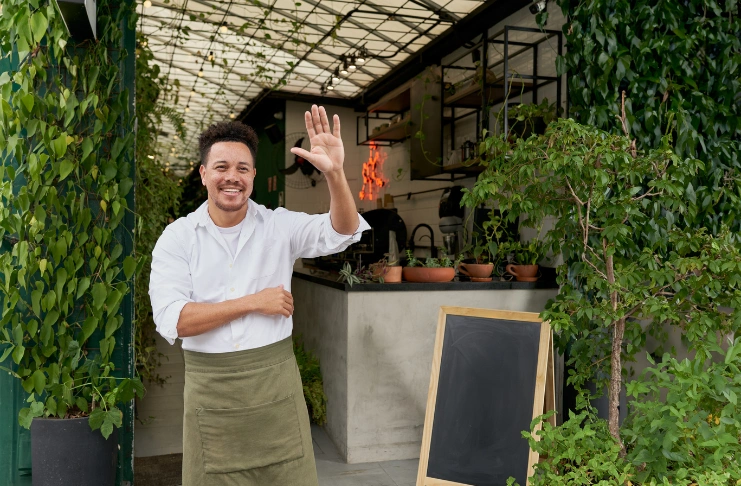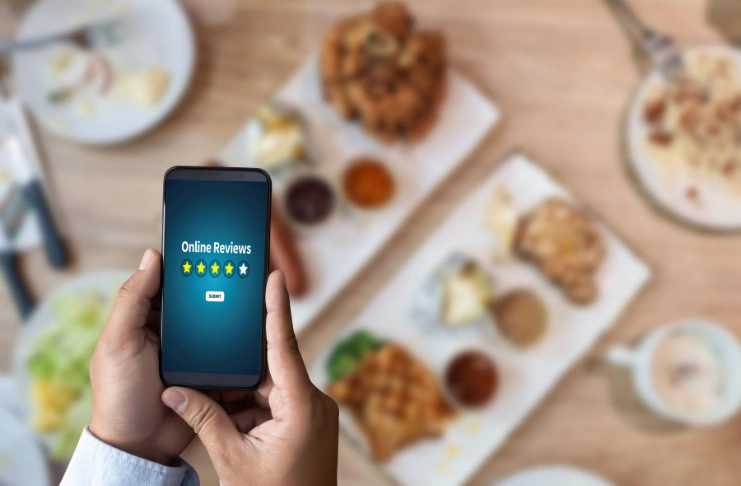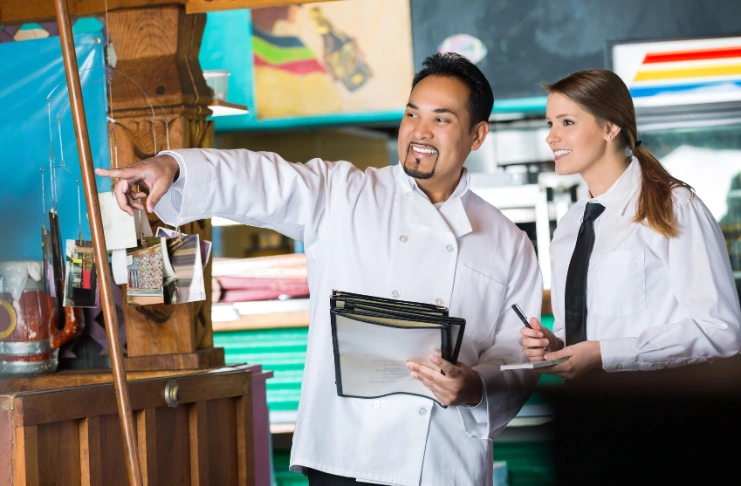Running a restaurant means juggling countless tasks daily. Between managing kitchen operations and serving customers, marketing often takes a backseat. Yet building strong public relations can transform your restaurant from another local spot into a community favorite that attracts new customers while keeping loyal ones coming back.
This guide lists proven steps to help you create a result-driven restaurant public relations strategy. You’ll learn how to strengthen your brand, manage your online reputation, connect with your local audience, and drive consistent foot traffic using smart, actionable PR tactics.
Why Does Restaurant Public Relations Matter?
Your restaurant’s reputation affects every aspect of your business. Positive reviews drive reservations. Negative reviews can empty dining rooms.
Public relations helps you control your narrative, build meaningful customer relationships, and create lasting brand recognition in your local community.
Smart restaurant owners understand that PR creates more than publicity. It builds trust, establishes credibility, and generates word-of-mouth marketing that money can’t buy.
How Do You Build Your Restaurant Brand Identity?

Your brand identity sets you apart from many restaurants competing for the same customers. It includes your restaurant’s personality, values, and the experience customers expect when they walk through your doors.
Start by defining what makes your restaurant unique. Maybe you source quality ingredients from local farms. Perhaps your chef trained in Italy. Or your family recipes span three generations. These elements become the foundation of your restaurant brand story.
Consistency strengthens brand identity across all touchpoints. Your website, social media profiles, menu descriptions, and staff interactions should reflect the same personality. A casual neighborhood bistro should feel welcoming and approachable, while an upscale steakhouse might emphasize sophistication and exclusivity.
Visual elements support your brand message. Choose colors, fonts, and imagery that match your restaurant’s personality.
What Are the Best PR Tips for New Restaurant Owners?
Opening a new restaurant means you’re starting from scratch. You don’t have loyal customers yet, but you do have an opportunity to shape your public image from day one. Here’s how to make that first impression count:
- Build buzz before you open. Start generating interest early. Reach out to local media with your story: why you opened, your restaurant concept, and what sets you apart. Local outlets often look for new business features, especially if there’s a good story behind it.
- Partner with food influencers and bloggers. Host a soft launch and invite local influencers or food bloggers. A small, invite-only event can lead to social media coverage, early online reviews, and word-of-mouth that attracts potential diners even before your official opening.
- Document your restaurant’s journey from construction to opening day. Share behind-the-scenes content on social media platforms. Show your team preparing for service, highlight menu items being developed, and introduce staff members. This content creates a connection before customers even taste your food.
INDUSTRY INSIGHT
| Public relations is becoming a strategic cornerstone for U.S. restaurants navigating a crowded and competitive market. With the global PR market projected to exceed $133 billion by 2027, restaurants are increasingly investing in earned media, influencer partnerships, and community engagement to build brand equity. In fact, organic media coverage (like customer reviews, local press, and social mentions) is perceived as more trustworthy than paid ads. Meanwhile, the rise of digital platforms has made it easier for independent operators to secure visibility through storytelling, community events, and smart reputation management. As PR becomes a driver of differentiation, restaurants that invest in authentic engagement and consistent brand messaging are gaining a competitive edge. |
How Can You Handle Negative Reviews Effectively?

Negative reviews sting, but they’re inevitable in the restaurant business. Your response to criticism often matters more than the original complaint. Handle negative reviews professionally and promptly to show other customers you care about their experience.
Read each negative review carefully before responding. Some complaints highlight legitimate issues you can fix. Others might stem from misunderstandings or unrealistic expectations. Tailor your response to address the specific concerns raised.
Respond publicly to show transparency, then move the conversation private when appropriate. Acknowledge the customer’s experience, apologize for any shortcomings, and explain how you’re addressing the issue. Invite them back to give you another chance.
Use negative feedback as improvement opportunities. If multiple reviews mention slow service, examine your staffing during peak hours. If customers consistently complain about a specific menu item, consider revising the recipe or preparation method.
Never argue with reviewers or make excuses. Even justified defensive responses often backfire, making you appear unprofessional to potential customers reading the exchange. Stay calm, take responsibility, and focus on solutions.
What Role Does Social Media Play in Restaurant Marketing?
Social media transforms restaurant marketing by putting your brand directly in customers’ hands. Platforms like Instagram, Facebook, and TikTok let you showcase delicious food, share your restaurant’s personality, and engage with your community daily.
Visual content drives social media success for restaurants. High-quality photos of menu items, behind-the-scenes kitchen shots, and customer dining experiences perform well across platforms. Invest time in photography or hire professionals for key images that represent your brand.
User-generated content amplifies your reach organically. Encourage customers to share photos of their meals and experiences. Create branded hashtags, offer incentives for posts, and regularly share customer content on your profiles. This authentic content often influences potential customers more than traditional advertising.
Consistency matters more than frequency on social media. Post regularly but focus on quality content that adds value for followers. Share recipes, cooking tips, staff spotlights, or community involvement rather than constantly promoting sales.
Engage authentically with your audience. Respond to comments, answer questions, and participate in local online conversations. Social media works best as a two-way communication tool, not a broadcasting channel.
How Do You Build Relationships with Local Media?

Local media outlets remain powerful allies for restaurant PR. Newspapers, magazines, radio stations, and local TV channels reach your target audience and carry credibility that social media posts can’t match. Building relationships with journalists and editors pays dividends over time.
Research local media to understand their coverage areas and preferences. Food writers focus on restaurant reviews and culinary trends. Business reporters might be interested in your economic impact or employment story. Lifestyle editors could feature your restaurant in community event coverage.
Make journalists’ jobs easier by providing relevant information when they need it. Keep a media kit ready with high-resolution photos, menu highlights, chef biographies, and restaurant background information. Respond quickly to media inquiries and be available for interviews.
Pitch stories beyond restaurant reviews. Share news about special events, charity partnerships, award wins, or unique menu additions. Local media often seeks community-focused content that highlights businesses contributing to the area’s vitality.
Develop genuine relationships rather than purely transactional contacts. Invite food writers to special tastings or events. Remember their preferences and interests. These personal connections lead to better coverage and more story opportunities.
What Types of Events Should Restaurants Host?
Events create excitement, drive sales, and give you valuable content for marketing. They help fill tables during slower periods and leave customers with memorable experiences that lead to repeat visits and positive reviews.
So, what type of events should you host?
- Food festivals and tasting events: Showcase your culinary skills with tasting menus, chef collaborations, or wine pairing nights. Partner with local businesses to attract food enthusiasts who often share their experiences online.
- Run community-focused events: Support your local area by hosting fundraisers, sponsoring youth teams, or offering space for local meetings. These efforts show that your restaurant supports the local community and can lead to positive media coverage.
- Offer educational events: Cooking classes, ingredient deep-dives, or wine tastings help position your restaurant as a trusted expert. These will help you deepen customer relationships and support long-term customer loyalty.
- Plan seasonal celebrations: Use holidays, summer weekends, or harvest season to host themed events. These moments already come with built-in buzz and give customers more reasons to dine in. Promote early across social channels to build interest.
How Can You Generate Positive Reviews Organically?

Positive reviews drive new business more effectively than most advertising.
Focus on creating experiences so exceptional that customers want to share them rather than simply asking for reviews.
Exceptional service encourages organic reviews more than exceptional food alone. Train staff to exceed expectations through personal attention, menu knowledge, and problem-solving skills. Customers remember how you made them feel as much as what they ate.
Timing matters when encouraging reviews. The best moment is when customers clearly enjoy their experience, not when they’re paying the bill and ready to leave. Train servers to recognize these moments and make subtle suggestions about sharing their experience online.
Make reviewing easy by providing clear directions to review sites. Include QR codes on receipts or table tents that link directly to your Google Business profile or Yelp page. Remove friction from the review process while respecting customers who prefer not to participate.
Follow up thoughtfully with customers who had positive experiences. Send thank-you emails after special events or milestone celebrations. Include gentle reminders about sharing their experience online, but focus primarily on expressing genuine appreciation.
What Makes an Effective Restaurant PR Campaign?
Successful PR campaigns combine strategic planning with authentic storytelling. They highlight what makes your restaurant special while addressing your target audience’s interests and needs. The best campaigns feel natural rather than forced promotional efforts.
Start with clear objectives for each campaign. Are you introducing new menu items, building awareness for a grand opening, or managing reputation during challenging times? Your goals determine messaging, target media, and success metrics.
Develop compelling narratives that connect with your audience emotionally. Stories about family recipes, local ingredient sourcing, or overcoming challenges resonate more than generic promotional messages. Find the human elements that make your restaurant’s story worth telling.
Coordinate messaging across all channels for maximum impact. Your website, social media, press releases, and staff talking points should reinforce the same key messages. Consistency amplifies your campaign’s effectiveness and helps build brand recognition.
Plan campaigns around newsworthy moments. Restaurant anniversaries, award wins, new chef appointments, or major menu changes provide natural hooks for media coverage. Create news rather than waiting for it to happen.
How PR Agencies Help Build a Restaurant Public Relations Strategy?

Restaurant owners often wonder whether to handle PR internally or hire professional help. PR agencies bring expertise, media connections, and dedicated time that busy restaurant owners may lack. However, agencies must understand your restaurant’s unique personality and goals.
Evaluate PR agencies based on restaurant industry experience and local market knowledge. Agencies familiar with food media understand journalist preferences, seasonal story opportunities, and effective messaging for restaurant audiences. Local connections provide advantages for community-focused businesses.
Set clear expectations about deliverables, timelines, and communication preferences. Discuss how often you’ll receive updates, what types of coverage to prioritize, and how to handle potential crisis situations. Good agencies provide regular reporting on activities and results.
Budget realistically for professional PR services. Quality agencies charge accordingly for their expertise and connections. Consider PR as an investment in long-term brand building rather than a short-term expense. Evaluate ROI through increased awareness, customer acquisition, and positive reputation metrics.
Maintain involvement even with agency support. You know your restaurant better than any outside professional. Provide insights about your customers, share upcoming plans, and approve messaging before it goes public. The best agency relationships combine professional expertise with owner knowledge.
What Are Cost Effective PR Strategies for Small Restaurants?
You don’t need a big budget to make an impact. With the right approach, small restaurants can get meaningful PR results by focusing on what brings the most visibility for the least cost.
- Build community partnerships: Collaborate with local farms, nearby businesses, or community events. Cross-promotions and shared storytelling offer strong exposure and often attract local media attention. These partnerships also build goodwill with potential customers.
- Encourage user-generated content: Make your space Instagram-friendly and use branded hashtags to encourage sharing. Feature customer photos and posts on your social media channels. This builds trust and spreads your brand through real experiences.
- Train your staff to be brand ambassadors: Your team is one of your most powerful PR tools. A well-trained, enthusiastic staff delivers great service and naturally promotes your brand. Invest in service quality that creates positive experiences people want to talk about.
- Use simple, DIY PR tactics: Write your own press releases for updates, milestones, or community involvement. Stay active on social media. Reach out directly to local food bloggers and influencers. Consistency matters more than polish.
Done right, these low-cost strategies can help small restaurants build a strong public image without straining their budget.
How Do You Measure PR Success?

Measuring PR effectiveness helps justify investment and improve future efforts.
Track online reputation through review sites, social media mentions, and search results. Monitor review scores and sentiment over time. Positive trends indicate successful reputation management, while negative patterns suggest areas needing attention.
Measure media coverage quality, not just quantity. A single feature story in a respected local publication often provides more value than multiple brief mentions. Track coverage tone, key message inclusion, and website traffic or reservations.
Monitor customer acquisition sources to identify PR’s role in business growth. Ask new customers how they heard about your restaurant. Track website analytics for traffic sources following PR activities. Measure social media engagement and follower growth during campaigns.
Sales data provides the ultimate PR measurement. Compare revenue during PR campaigns to baseline periods. Track specific promotions or events featured in PR efforts. While multiple factors affect sales, successful PR should contribute to overall business growth.
Conclusion
Strong PR makes your restaurant part of the conversation. Keep showing up, keep telling your story, and make every guest experience worth sharing.
That’s how reputations grow, and tables stay full.
Frequently Asked Questions
1. How to do PR for a restaurant?
Start by defining your restaurant’s unique story and target audience. Build relationships with local media, maintain an active social media presence, encourage positive reviews, and engage with your community through events and partnerships.
2. What are the 5 P’s of public relations?
The 5 P’s are: People (target audiences), Purpose (clear objectives), Positioning (brand message), Presentation (how you communicate), and Performance (measuring results and adjusting strategies).
3. What are the 4 P’s of a restaurant?
The 4 P’s for restaurants are: Product (food and service quality), Price (menu pricing strategy), Place (location and atmosphere), and Promotion (marketing and advertising efforts).
4. What are the 4 P’s of public relations?
Public relations focuses on: Publicity (media coverage), Public Affairs (community relations), Public Opinion (reputation management), and Public Information (transparent communication).
5. What is the best way to advertise my restaurant?
Combine multiple channels, including social media marketing, local media coverage, online review management, community events, and word-of-mouth referrals for comprehensive restaurant promotion.
6. How do I attract customers to my restaurant?
Focus on exceptional food and service, maintain a strong online presence, encourage positive reviews, host special events, build community relationships, and create memorable dining experiences that generate word-of-mouth marketing.
7. What is the best promotion for a restaurant?
The most effective promotions combine limited-time offers with social media engagement, such as “check in for a free appetizer” or “share a photo for 10% off your next visit.”
8. What are the 4 P’s of marketing for restaurants?
Restaurant marketing includes Product (menu offerings and dining experience), Price (competitive pricing strategy), Place (location and ambiance), and Promotion (advertising and public relations activities).
9. How do you attract people’s attention in a restaurant?
Create visually appealing spaces, offer unique menu items, provide exceptional service, maintain an active social media presence, and develop signature dishes or experiences that encourage sharing.
10. What should be included in a PR strategy?
Include clear objectives, target audience identification, key messaging, media relations plan, crisis management procedures, content calendar, community engagement activities, and performance measurement metrics.
11. How much does restaurant PR cost?
PR costs vary widely based on scope and approach. DIY efforts might cost a few hundred dollars monthly for tools and materials, while professional PR agencies typically charge $2,000-$10,000 monthly, depending on services and market size.
12. What does PR mean in restaurants?
Restaurant PR encompasses all activities that build positive public perception, including media relations, review management, community engagement, crisis communication, and reputation building to attract and retain customers.





